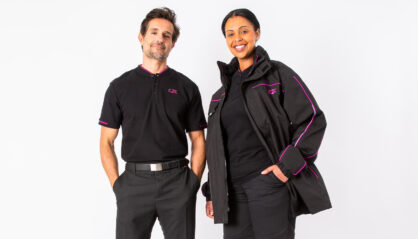How COVID-19 Changed Uniforms

COVID-19 has brought many challenges for people and industries all over the world. However, some sectors have had to adapt and reinvent themselves more drastically than others, one of them being the uniform sector.
The new normal in the majority of work environments is to be covered in some form of PPE. Customers are no longer met by a smile, but by a mask instead. It’s something that we’ve been forced to adjust to, for the protection of ourselves and the people around us.
Although a mask has become a part of everyday life and our appearance, for a lot of workers, that’s not the only thing that’s changed about their uniforms.
For many industries, it’s no longer just about the appearance of employees uniform, but how hygienic and safe it is. Companies now have to take into consideration a whole new range of factors when it comes to the design and supply of uniforms to their employees.
So, how exactly has COVID-19 changed uniforms?
Protecting People:
In many work environments, PPE was already worn to protect against health and safety risks. However, the range of PPE and the amount of people wearing it has vastly grown, to protect people in this health crisis.
Workers have had to adapt to some form of PPE becoming a part of their uniform, whether it’s a visor, mask (face covering), gloves or a disposable apron. In fact, it’s now mandatory by law to wear a visor AND a face mask when providing a close contact service, such as hairdressing, beauty salons and spas. This is because they can’t maintain social distancing and have to take extra precautions to protect themselves and the customer.
According to the , NHS Uniforms and workwear: Guidance for NHS employers “There is no conclusive evidence that uniforms and workwear play a direct role in spreading infection”. However, they do advise that staff uniforms should facilitate good care practices and minimise any risk to patients.
Wearer Well-being:
We’ve heard the importance of keeping people around us safe, but what about the wearer themselves? In these times of trouble, uniforms have to be updated to consider wearer well-being and safety and technology now more than ever can help.
An example is Barrier Masks , unlike simple ‘face-covering’ masks, these ones are designed as a commercial alternative to a surgical mask. They’re made from 3 layers of fabric, fixed together at the edge of the mask. The primary function of the masks is to reduce the spread of infection to others and also provide a protective barrier against bacteria or viruses from a nearby person. They’re designed to completely cover the nose and mouth, reaching from the bridge of the nose, across the cheeks and under the chin.
A 3-Ply Barrier Mask should have three layers, the first one being an inner layer, which has a soft woven breathable fabric that can be worn comfortably on the skin. The mid-layer should feature a fixed or removable filtration (nonwoven) fabric providing anti-bacterial filtering properties. Finally, the outer layer should consist of a woven anti-microbial fabric that’s coated with a water repellent treatment against droplets.
There’s also more advanced testing and standards introduced, so the effectiveness of your mask can be measured. As the properties of a Barrier Mask resemble those of a surgical mask, the quality of your mask’s properties can be tested against the same criteria, standards and certifications, ensuring that your mask will protect the wearer’s well-being.
Comfort Over Style:
For employers, it’s vital to remember that not every work environment will have the same demand for PPE and they have a duty of care to ensure employees are comfortable whilst working, and breathability is key in face coverings. The lower the differential pressure the more breathable the mask.
It’s so important to supply PPE that is designed around comfort, fit and style. This ensures that workers will be more motivated to wear them and can carry out their work to their full capability. If an employee has to work in an ill-fitted uniform, it could restrict movement and have an impact on their work performance.
The UK PPE regulations (Personal Protective Equipment at Work Regulations 1992) states that ‘the aim should be to choose PPE which gives maximum protection while ensuring minimum discomfort to the wearer’. Remember, there’s no such thing as an average person, no-one-is-uniform and one size does not fit all!
Sustainable Sourcing:
In this age of precaution and uncertainty, it’s easy to fall into a one-wear and dispose of frame of mind. Although we are encouraged to wear face coverings, many of which are disposable, there are many customised and reusable options on the market.
If you’re a brand that values sustainability and ethical sourcing, your uniform has to reflect that as well. If you’re using disposable masks but urging people about the importance of our environmental crisis, you’ll lose brand identity and customer trust.
Thankfully after months of adjusting to face coverings, brands worldwide are now shifting production efforts to craft affordable face masks out of cotton, hemp, deadstock fabric, and other sustainable materials. However, it’s important to note that these types of face masks aren’t the same as medical-grade masks, which provide further protection from the virus.
Summary:
It’s clear that COVID-19 has had a profound impact on uniforms and the factors that organisations have to consider when designing and supplying PPE to their employees. For some workers, PPE will be a part of their uniform for a long time and it’s uncertain whether the uniform sector will be changed for good.
If you’re looking to design customised PPE that can protect your staff and customers, build brand trust and protect your business, we can help! At Jermyn Street Design, we have been pioneering Personal Protective Uniforms.
When COVID-19 hit Europe, we were able to source, manufacture and supply certified PPE at speed and scale to the UK’s NHS and other frontline workers. We have since applied this technical knowledge to our clients’ needs for PPU, that truly take into consideration wearer well-being, job performance, customer interaction and brand trust, as well as other critical corporate considerations such as sustainability and ethical sourcing.
We now provide masks and snoods designed for the specific needs of customer-facing staff in the service industries.
Remember, no one is uniform, and no two companies have exactly the same demands for PPE.





